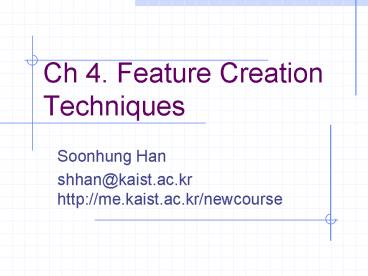Ch 4. Feature Creation Techniques - PowerPoint PPT Presentation
1 / 27
Title:
Ch 4. Feature Creation Techniques
Description:
Part is subtracted from its convex hull ... feature definition('declaration') parted from. implementation. similar to variational modeling ... – PowerPoint PPT presentation
Number of Views:53
Avg rating:3.0/5.0
Title: Ch 4. Feature Creation Techniques
1
Ch 4. Feature Creation Techniques
- Soonhung Han
- shhan_at_kaist.ac.kr
- http//me.kaist.ac.kr/newcourse
2
PART ? BACKGROUND 1 Introduction 2 Geometric
Modeling PART ? FUNDAMENTALS 3 Feature
Concepts 4 Feature Creation Techniques PART ?
APPLICATION OF FEATURES 5 Features in Design 6
Features in Manufacturing 7 Feature Mapping and
Data Exchange PART ? DESIGN AND IMPLEMENTATION 8
Design-by-Features Techniques 9 Feature
Recognition Techniques 10 Implementation
Tools 11 Feature-Based Process Planning 12
Future CAD/CAM Technologies
3
4. Feature Creation Techniques 4.1
Overview 4.2 Interactive Feature Creation
4.3 Automatic Feature Recognition 4.4
Design by Features 4.5 Comparison of
Feature Creation Techniques 4.6
Unification of Feature Creation Techniques
4
4.1 Overview
- Geometry B-rep, CSG
- Feature clustering, properties, relationship,
higher level data - 2 main categories FfG (feature recognition) and
GfF (design by feature) - automatic recognition vs. human-assisted
(interactive) recognition - 1) interactive picking, Fig.4.2a
- 2) automatic recognition Fig.4.2b
- 3) design by features geometric models are
generated from the features, Fig.4.2c
5
B-rep
(design by feature)
(feature recognition)
6
picking
7
(No Transcript)
8
4.2 Interactive Feature Creation
- Record pointers to the entities picked with a
feature name. - Augmented with attributes tolerance, finish,
nominal parameters (e.g. hole diameter) - Disadvantage
- User is responsible for validation
- Semantic level of information is low
- Restrict users to a pre-defined set of features
at the cost of flexibility
9
4.3 Automatic Feature Recognition
- 4.3.1 Machining Region Recognition
- Sectioning
- Convex hull decomposition
- Cell decomposition
- 4.3.2 Pre-defined Feature Recognition
- Boundary-based methods
- Volume-based methods
10
4.3.1 Machining Region Recognition
- Generate NC tool paths directly from CAD database
- Determine volumes that to be removed by machining
(end milling) - No comparison (matching) to pre-defined shapes
11
Sectioning
- Feature boundaries at each Z-level in 2.5D
milling - Principal feature directions coincide with the 3
milling axes - Sliced with x-y planes at fixed Dz positions
tool positions - Intersection profiles
- Offset curves
- RP (rapid prototyping) .stl
12
Convex hull decomposition
- Decompose a volume into convex machining volumes.
- Part is subtracted from its convex hull
- Kim Y.S.(???) overcome original algorithm by
partitioning - Tony Woo of U of Washington gt VP of NTU (Nanyang
Tech U.)
13
Cell decomposition
- Spatial equivalent of sectioning method
- Partitioning produces a lattice of cubes
- Cells are classified as stock cells or part
calls. - Stock cells to be removed
- Cell size is chosen by feed amount
14
4.3.2 Pre-defined Feature Recognition
- Portions of the geometric model are compared to
pre-defined generic features - Search the geometric models to match (topological
and geometric) patterns - Extract recognized features from the geometric
model (remove the portion) - Determine feature parameters (hole dia., pocket
depth) - Complete the feature geometry (edge/face growing,
closure) - Combine simple features to get high-level features
15
Boundary-based methods
- Geometric and topological conditions that need to
be satisfied are identified. - Search a model whether the conditions
corresponding to each feature are present. - 3 sub-classes rule-based, graph-based, syntactic
(syntax) method - Neural-net-based system is a special case of
rule-based system allow probabilistic
recognition of partial features that result from
feature interaction.
16
Topological conditions
- of topological entities, their adjacencies
- Topological conditions alone are usually
insufficient. - Use material and geometric conditions as well
- Material condition Solid sides or void side of a
feature. Measure solid angles between adjacent
faces - Geometric condition planar, cylindrical,
perpendicular, parallel
17
Fig.4.4 Different features with the same topology
material and geometric conditions are different
18
X convex V concave
Step
V-slot
Fig. 4.5 Insufficient resolution
19
Rule-based recognition
- Production rules
- Trial and error to see whether a set of rules are
necessary and sufficient (complete) - Exhaustive search of model DB Long search time
for large models and complex rules - Expert system, KBS (knowledge-based system)
20
Graph-based methods
- Match sub-graphs
- Separate data structure face adjacency graph
(FAG) - Node represents face, arc represents adjacency
- Geometry information as attributes of arc
- Hybrid graph-based algorithm to find general
features, and rules to recognize specialized
features
21
(No Transcript)
22
Fig.4.7 Sub-graph for thru-slot and blind-step
23
Syntactic pattern recognition
- Adapted from vision system
- Geometric patterns described by a series of
straight, circular, curved line segments. - Languages for describing the sequences
algebraically - Parsing
24
Neural net
- Probabilistic methods
- Feature interaction alters the topology, it
remove portions of features. - Unable to recognize partial or incomplete
features Hint-based recognition - F13 disappear, F9 split into 2 faces, FAG changed.
25
Volume-based methods
- Operate directly on CSG tree match sub-trees
- Produce and classify volume features from B-rep
- Identify the material to be removed from a base
stock - Decompose this volume into delta volume Units
corresponding to machining operations.
26
Delta volumes
- Delta volumes are classified according to their
DoF cutting tool motion needed to produce the
volume. - 1 DoF hole
- 2 DoF linear sweeping (through-slot)
- 2.5 DoF sweeping along a planar curve (pocket)
27
4.4 DESIGN BY FEATURES
Feature library - including generic feature
definitions
Constraint management 1) Procedural
approach features sets of procedures feature
constraints inside the procedures similar to
parametric modeling 2) Declarative
approach features sets of constraints feature
definition(declaration) parted from
implementation similar to variational modeling































